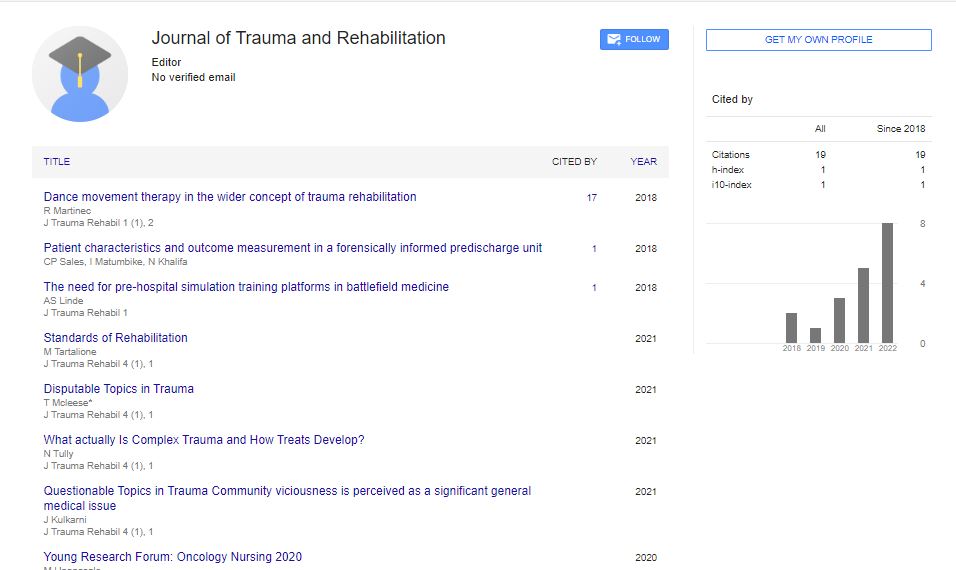Perspective, J Trauma Rehabil Vol: 6 Issue: 2
Traumatic Stress in the Workplace: Strategies for Employee Well-being
Moshier Marx*
1Department of Medicine, Columbia University, New York, United States of America
*Corresponding Author: Moshier Marx,
Department of Medicine, Columbia
University, New York, United States of America
E-mail: marx.45@cu.edu
Received date: 29 May, 2023, Manuscript No. JTR-23-106886;
Editor assigned date: 31 May, 2023, PreQC No. JTR-23-106886 (PQ);
Reviewed date: 14 June, 2023, QC No. JTR-23-106886;
Revised date: 21 June, 2023, Manuscript No. JTR-23-106886 (R);
Published date: 28 June, 2023, DOI: 10.4172/Jtr.1000126
Citation: Marx M (2023) Traumatic Stress in the Workplace: Strategies for Employee Well-being. J Trauma Rehabil 6:2.
Description
The modern workplace can be a source of both fulfillment and stress for employees. While many jobs offer opportunities for growth and satisfaction, they can also expose individuals to various stressors, including traumatic events. Traumatic stress in the workplace refers to the emotional and psychological impact of experiencing or witnessing distressing events while on the job. These events can range from accidents and workplace violence to natural disasters and other emergencies. Managing traumatic stress is essential for preserving employee well-being, productivity, and overall workplace morale.
Understanding traumatic stress in the workplace
Traumatic stress in the workplace can arise from several sources, such as:
Accidents and injuries: Work-related accidents resulting in injuries or fatalities can have a significant emotional impact on employees who witness or experience them.
Workplace violence: Incidents of harassment, bullying, or physical violence can lead to traumatic stress and emotional trauma for affected employees.
Natural disasters: Employees may experience traumatic stress when their workplaces are affected by natural disasters, such as floods, earthquakes, or wildfires.
Importantcal incidents: High-stress situations, such as medical emergencies or severe customer interactions, can also trigger traumatic stress in employees.
Impact on employee well-being
Traumatic stress in the workplace can have a detrimental effect on employee well-being and overall job performance:
Mental health: Employees may experience symptoms of Post- Traumatic Stress Disorder (PTSD), anxiety, depression, and other mental health issues as a result of traumatic experiences.
Physical health: Prolonged exposure to traumatic stress can lead to physical health problems, including headaches, sleep disturbances, gastrointestinal issues, and compromised immune function.
Job performance: Traumatic stress can impair concentration, memory, and decision-making abilities, resulting in reduced productivity and job performance.
Workplace relationships: Employees may struggle to engage with coworkers and may withdraw from social interactions, affecting team dynamics and collaboration.
Strategies for supporting employee well-being
To promote employee well-being and resilience in the face of traumatic stress, organizations can implement various strategies:
Develop a supportive workplace culture: Fostering a culture of empathy, open communication, and mutual support can develop a sense of belonging and encourage employees to seek help when needed.
Trauma-informed training: Provide employees with training on recognizing signs of traumatic stress, offering appropriate support, and facilitating referrals to mental health resources.
Establish support networks: Designate peer support groups or mentors within the workplace to provide an additional layer of support for employees experiencing traumatic stress.
Mental health resources: Ensure that employees have access to confidential and comprehensive mental health resources, including Employee Assistance Programs (EAPs) and counseling services.
Flexibility and accommodation: Offer flexibility in work hours or job duties to accommodate employees dealing with traumatic stress, as this can help reduce stress and facilitate recovery.
Training in resilience and coping: Provide training programs that focus on building resilience and coping skills to help employees better navigate challenging situations.
Occupational health and safety: Prioritize workplace safety measures to prevent traumatic events and reduce the risk of accidents or violence..
Managerial support and communication
Managers play a vital role in supporting employees experiencing traumatic stress:
Promote open communication: Encourage employees to communicate their needs and concerns regarding their well-being. Ensure that managers are approachable and actively listen to employees.
Provide emotional support: Show empathy and compassion to employees who have experienced traumatic events. Acknowledge their feelings and validate their experiences.
Manage workloads: During times of traumatic stress, consider redistributing workloads or providing temporary relief to employees to help alleviate additional stress.
Monitor employee well-being: Pay attention to changes in employees' behavior and performance, and be attentive to signs of distress or trauma.
Referral to resources: Managers should be aware of available mental health resources and be prepared to refer employees to appropriate support services.
Conclusion
Traumatic stress in the workplace can significantly impact employee well-being and job performance. Organizations can play a pivotal role in mitigating the effects of traumatic stress by implementing supportive measures and fostering a culture of well-being. Providing access to mental health resources, promoting open communication, and offering resilience training are essential strategies for supporting employees facing traumatic stress. By prioritizing employee well-being and developing a safe and supportive work environment, organizations can empower their workforce to cope with traumatic stress effectively and promote a healthier and more resilient workforce.
 Spanish
Spanish  Chinese
Chinese  Russian
Russian  German
German  French
French  Japanese
Japanese  Portuguese
Portuguese  Hindi
Hindi 